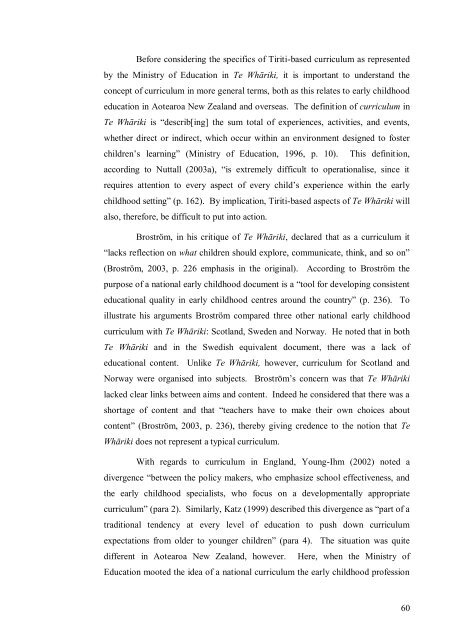supporting tiriti-based curriculum delivery in mainstream early ...
supporting tiriti-based curriculum delivery in mainstream early ...
supporting tiriti-based curriculum delivery in mainstream early ...
You also want an ePaper? Increase the reach of your titles
YUMPU automatically turns print PDFs into web optimized ePapers that Google loves.
Before consider<strong>in</strong>g the specifics of Tiriti-<strong>based</strong> <strong>curriculum</strong> as represented<br />
by the M<strong>in</strong>istry of Education <strong>in</strong> Te Whāriki, it is important to understand the<br />
concept of <strong>curriculum</strong> <strong>in</strong> more general terms, both as this relates to <strong>early</strong> childhood<br />
education <strong>in</strong> Aotearoa New Zealand and overseas. The def<strong>in</strong>ition of <strong>curriculum</strong> <strong>in</strong><br />
Te Whāriki is “describ[<strong>in</strong>g] the sum total of experiences, activities, and events,<br />
whether direct or <strong>in</strong>direct, which occur with<strong>in</strong> an environment designed to foster<br />
children‟s learn<strong>in</strong>g” (M<strong>in</strong>istry of Education, 1996, p. 10). This def<strong>in</strong>ition,<br />
accord<strong>in</strong>g to Nuttall (2003a), “is extremely difficult to operationalise, s<strong>in</strong>ce it<br />
requires attention to every aspect of every child‟s experience with<strong>in</strong> the <strong>early</strong><br />
childhood sett<strong>in</strong>g” (p. 162). By implication, Tiriti-<strong>based</strong> aspects of Te Whāriki will<br />
also, therefore, be difficult to put <strong>in</strong>to action.<br />
Broström, <strong>in</strong> his critique of Te Whāriki, declared that as a <strong>curriculum</strong> it<br />
“lacks reflection on what children should explore, communicate, th<strong>in</strong>k, and so on”<br />
(Broström, 2003, p. 226 emphasis <strong>in</strong> the orig<strong>in</strong>al). Accord<strong>in</strong>g to Broström the<br />
purpose of a national <strong>early</strong> childhood document is a “tool for develop<strong>in</strong>g consistent<br />
educational quality <strong>in</strong> <strong>early</strong> childhood centres around the country” (p. 236). To<br />
illustrate his arguments Broström compared three other national <strong>early</strong> childhood<br />
<strong>curriculum</strong> with Te Whāriki: Scotland, Sweden and Norway. He noted that <strong>in</strong> both<br />
Te Whāriki and <strong>in</strong> the Swedish equivalent document, there was a lack of<br />
educational content. Unlike Te Whāriki, however, <strong>curriculum</strong> for Scotland and<br />
Norway were organised <strong>in</strong>to subjects. Broström‟s concern was that Te Whāriki<br />
lacked clear l<strong>in</strong>ks between aims and content. Indeed he considered that there was a<br />
shortage of content and that “teachers have to make their own choices about<br />
content” (Broström, 2003, p. 236), thereby giv<strong>in</strong>g credence to the notion that Te<br />
Whāriki does not represent a typical <strong>curriculum</strong>.<br />
With regards to <strong>curriculum</strong> <strong>in</strong> England, Young-Ihm (2002) noted a<br />
divergence “between the policy makers, who emphasize school effectiveness, and<br />
the <strong>early</strong> childhood specialists, who focus on a developmentally appropriate<br />
<strong>curriculum</strong>” (para 2). Similarly, Katz (1999) described this divergence as “part of a<br />
traditional tendency at every level of education to push down <strong>curriculum</strong><br />
expectations from older to younger children” (para 4). The situation was quite<br />
different <strong>in</strong> Aotearoa New Zealand, however. Here, when the M<strong>in</strong>istry of<br />
Education mooted the idea of a national <strong>curriculum</strong> the <strong>early</strong> childhood profession<br />
60
















